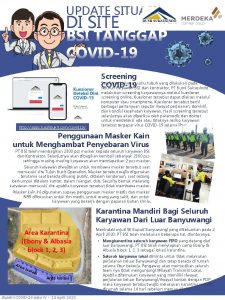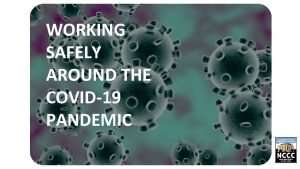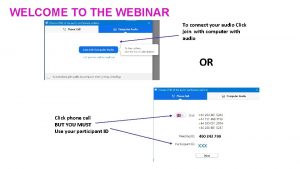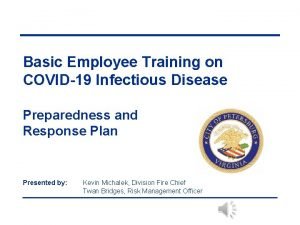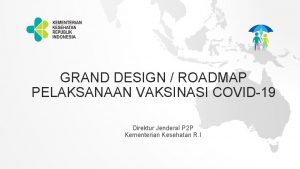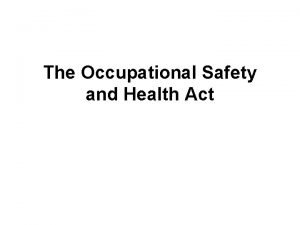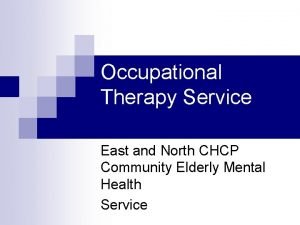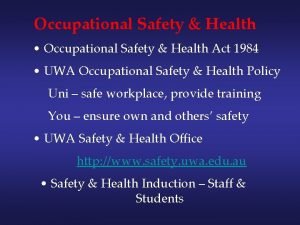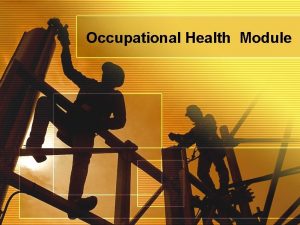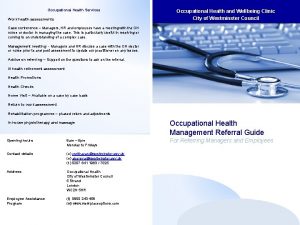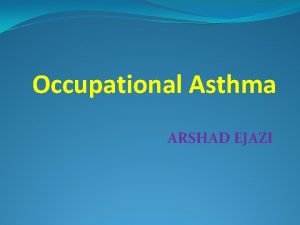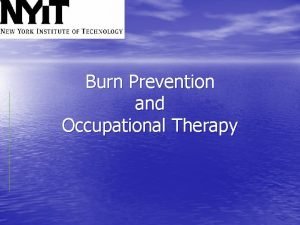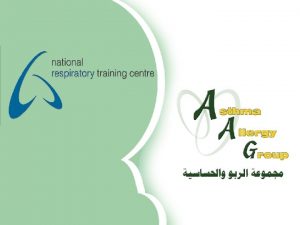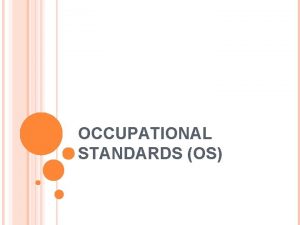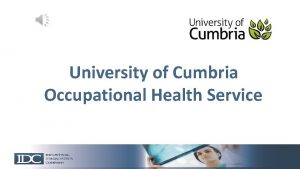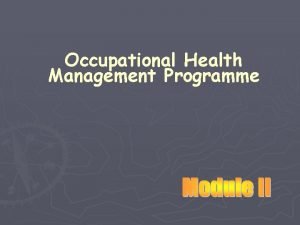COVID19 Secure Occupational Health In light of COVID19











- Slides: 11

COVID-19 “Secure” Occupational Health In light of COVID-19, all OH services will need to update previous risk assessments and put in place suitable and sufficient measures to protect both OH staff and service users. This SOM & FOM guidance aims to set out a range of factors to consider in relation to face clinical services. It is being provided now, primarily to allow OH providers time to prepare the very best safeguards for its workforce in advance of a future return to more widespread face to face work. There is also an awareness that there may be some exceptional cases where individual employees do need to be seen sooner; where there is a clear justification for this and a detailed risk assessment process will be essential. Equally some very high risk safety critical industry sectors may be required to return to face work sooner than others. The aim must be to keep both OH and client workforces as safe as possible. All OH providers plans must respect any devolved guidance for clinics in the different nations of the United Kingdom. Those providing services to the NHS or MOD should consider any internal guidelines to supersede any aspect of these which conflict. It is important to remember this is a rapidly changing. picture in terms of geographical hotspots, clinical knowledge - therefore regular reviews of risk assessments will be needed. 11 th June 2020 1

Remote or face to face? There has been a large increase in home and remote working to eliminate the occupational risk from COVID-19 and to help protect both OH staff & patients. It would not be appropriate to immediately return to previous full face to face models while the COVID 19 risk remains heightened. You should consider what is essential face to face, what is desirable face to face and what can be done remotely. As the risk of infection in the general community reduces further, the F 2 F risk vs F 2 F benefit will change. You should be aware of the likely risk of infection in the population you provide services for. Key features of videocalls are they need to be sure data is appropriately encrypted to maintain the security of confidential information. Phone and videocalls can be used to cover many OH topics very successfully. If your only reasoning for face to face is familiarity, consider some additional training for telephone/remote clinics. Here is the link to an SOM webinar on remote consultations: https: //www. youtube. com/watch? v=f. V 35 Dx. Md. Yu 4&feature=youtu. be In terms of making the choice between remote and face to face OH assessment, please see any industry specific guidance as many have set out their own national expectations, extensions or exemptions process. For example, HAVS tier 4 assessments as of June 2020, HSE have advised face to face is only likely to be needed for exceptional cases Links to many of the key industry specific guidelines are shown overleaf. 2

Industry Specific Medicals – OH guidance Aviation https: //www. caa. co. uk/Licences-and-other-Approvals/COVID-19 -Exemption/ AME’s have also been emailed further guidance on 18 th May with further information on CAA current position in England. DVLA D 4 https: //www. gov. uk/government/publications/applications-for-renewing-lorry-and-bus-driving-licences-atage-45 -and-over-during-the-coronavirus-covid-19 -pandemic/important-applications-for-the-renewal-oflorry-and-bus-driving-licences-during-the-coronavirus-pandemic HSE (Lead, Asbestos, COSHH, Noise, Radiation) https: //www. hse. gov. uk/news/health-surveillance-coronavirus. htm HSE (diving) https: //www. hse. gov. uk/news/divers-medical-certificate-extension-coronavirus. htm HSE (HAVS) https: //www. fom. ac. uk/wp-content/uploads/Remote-assessment-of-hand-arm-vibration-syndrome-and-carpaltunnel-syndrome-v 2. pdf. Oil &Gas UK https: //oilandgasuk. co. uk/covid-19/ Railway (ORR) https: //orr. gov. uk/coronavirus-advice Seafarer -MCA (ENG 1 & ML 5) https: //assets. publishing. service. gov. uk/government/uploads/system/uploads/attachment_data/file/877800/Revis ed_medical_fitness_certificate_policy_during_COVID-19_pandemic_information_for_Seafarers_0104_002. pdf It is important to have processes in place to monitor for changes in this guidance 3

Key info to enable comprehensive risk assessment Likelihood patient is contagious? Primarily this will depend on the level of infection in the local area where the OH assessment takes place; thus monitoring for local outbreaks will be important. A low R (below 1) will help indicate a more stable picture for planning clinics in future weeks. Where R increases above 1, expect local levels of infection to be increasing and therefore this should be marker to reconsider the situation. Those with COVID-19 are infectious to others from 2 -3 days BEFORE symptoms. Those unwell MUST isolate for a minimum of 7 days. At which point it is also important they have not had no fever for 48 hours off paracetamol. ANTIGEN PCR testing has shown in multiple research papers for COVID-19 to be variable between cases. Generally it is thought to be in higher quantities for longer the more severe the infection. Routes of transmission ? This can be direct respiratory via breathing in COVID-19 from the air. It can also be due to splatter or splashes in terms of individual coughing or sneezing close by landing directly on the face. Alternatively it may be indirectly by touching of contaminated surfaces and then touching your eyes, mouth or face. When a patient is shouting, singing or breathing heavily during exercise more respiratory droplets are likely to be produced and released into the air, which increases the risk to other parties in that close environment breathing the air. There is no research in terms of infection risk from those sobbing and tearful. If a patient/service user does become emotional in clinic, having tissues readily available for a “catch it, bin it, kill it” approach in the same way as coughing and sneezing would be a sensible mitigation to help minimise potential risk to the clinician. What impacts the exposure level? Reducing time, Increasing distance and adding physical barriers are all parameters that can reduce infection risk. The longer you are with someone who has COVID-19 the more likely you will become ill. Therefore keeping face to face clinical time as short as possible is important. The closer you are the higher this risk. Masks, face shields, Perspex screens all act as physical barrier to reduce risk. Selecting control measures using hierarchy of control. When choosing which control measures, it is best to follow the usual OH principle of the hierarchy of control. Measures at the top are more effective. Combinations of control measures may potentially reduce risk further. 4

KEY TOPICS FOR RISK ASSESSMENT The next few pages set out 4 key domains and within that a range of factors specific to occupational health that you will need to consider when returning to face clinical practice. The most appropriate control measures will vary from organisation to organisation in line with different industry sectors they provide advice to and where within the UK they are based. Measures in this guidance are to assist your approach, with ideas which will help you to create a COVID Secure workplace for your staff and patients. In the further reading at the end of this guidance is the government advice for office areas. Systems need to be preplanned, well communicated. 1 – Patients 2 - All OH Staff based in clinical setting 3 – Clinic Setting/Premises 4 – High risk clinical procedures 5

1 – Patient Journey Before During After • Communication – Good practice would be to set expectations with good communication prior to clinic. You may wish to ask they minimise bringing coats/bags into the clinic room. • Pre-screening – It would be advisable to check in advance for symptoms, recent contacts or relevant travel. Questions will need to be regularly reviewed to meet current public health measures. Temperature checking will assist this process. • Reduce F 2 F time - Ideally paperwork should be completed in advance, if this is not possible then to be done in a different area to the clinician. Electronic questionnaires reduce the need for physical contact/handling. Although clear plastic wallets can be used for actual papers, so the clinician does not need to touch or handle the pages directly. The plastic can be wiped clean before passing to administrative teams. Administrators should not remove paperwork from these for at least 72 hours. • Hygiene – Pop up hand cleaning stations so patients can use alcohol gel prior to entering clinic room. • Increase Distance - Room set up to maximise distance between patient and clinician. Where there is a choice of rooms, use the biggest available, the larger the air volume the more dilute any viral shedding will be and the easier it is to social distance. • Clean Air – Room to be set up to maximises ventilation & recycling of fresh air – via windows/doors/air conditioning systems measures that do not breach confidentiality • Patient masks – NHS & WHO both suggest patients wearing facial coverings/masks, you may wish to review what is most appropriate in you location and circumstances. • Any medical equipment – only use freshly cleaned stethoscope, otoscope, audio headset etc on each new patient. • Breaking infection chain - Waste facilities and processes need to be in place for the patient to remove any mask worn and use alcohol gel their hands or wash hands • Gaps – Sufficient time is needed between patients to allow the room to be appropriately sanitized. • Open Windows – this will allow an exchange of air from the previous patient before the next arrives. • Rotate rooms – if there are spare clinic rooms, then using 2 per clinician allows for alternating between rooms, so air can settle before cleaning. • Certificates/letters - You may wish to consider electronic certificates or for paper certificates using wipeable plastic wallets, which can be put on the side for the patient to collect, once you are 2 m away. 6

2 - OH Employee Health & Safety Teams/Pairings OH Clinician Vulnerability Where clinicians need to work together in a room on a regular basis, consider A holistic approach to assess all relevant risk factors and protected consistent pairings to reduce the total number of different interactions over the course characteristics should be made: of a working week. □ Age □ Ethnicity □Disability □ Sex https: //www. fom. ac. uk/wp-content/uploads/Risk-Reduction-Framework-for-NHS-staff. Adjusting clinical examination at-risk-of-COVID-19 -infection-12 -05 -20. pdf You may wish to review your personal style to minimise any close face to face time for example - turning your face/mouth away from the patient when listening to heart Test &Trace or lungs. Or whilst stood 2 m away, ask patients to copy your moments instead of OH staff with any relevant symptoms must self isolate as per UK guidelines. assessing limbs directly. They should also avoid face to face clinical work if anyone in their household is unwell or they are contacted by the UK test and trace Instruction, Training & Fitting processes and requested to self isolate. Any work whilst “isolating” MUST All employees should be appropriately trained in relevant factors: be from home. Processes need to be in place for short notice isolation due ❑ Correct Donning & Doffing of PPE. to staff or their household becoming unwell or contact from test & trace ❑ Face fit for masks. Teams. You may wish to consider updating consent procedures to allow ❑ Understanding of new infection prevention and control processes. clinic patients who will have close contact with OH staff personal information ❑ Understanding of new cleaning procedures. to be shared with Test & Trace if a clinician were to become unwell. ❑ Understanding new waste disposal procedures. ❑ Training on new steps for the safe collection and disposal of Body Fluids. PPE At minimum follow the most up to date agreed national guidelines that NHS are using ❑ Safe procedures for dealing with splashes and spillages. ❑ Awareness of COVID-19 alterations to resuscitation guidelines. after agreement with the HSE/Academy of Royal colleges. https: //www. gov. uk/government/publications/wuhan-novel-coronavirus-infection. OH Employee Consultation & Wellbeing prevention-and-control Employers have a duty to consult their employees on matters of health and safety. Aim to create positive collaboration to increase trust and allow for joint problems Business travel solving. The mental health and wellbeing of staff should also be considered and Where OH staff need to stay away from their home, centrally logging the appropriate levels of support given. stay and making sure any overnight accommodation meets social distancing requirements are important. 7

3 - Premises - Clinic Setting Areas to be reviewed Factors to consider Waiting area Enhanced Cleaning plans Emergencies (Fire/First aid) Water systems & leigionella Windows or Air conditioning Toilets & Water systems Clinical Rooms Corridors Staying COVID-19 Secure in 2020 poster o Some OH clinics are on their own premises, but this also applies to o If you have reception staff, you may wish to consider clear screens as o Risk assessment and planning needs to be undertaken in advance of o Remove unnecessary objects from waiting areas and surfaces in clinics are done at client sites or in vehicles. all clinics irrespective of property ownership. o Consider who is essential to be in clinical areas, all other staff should be moved to locations with lower throughput of people. a measure to separate patients and staff. clinical rooms. Items inside cupboards are less likely to be contaminated by coughs or sneezes. o Where recommissioning areas that have not been used for a period of time, following HSE guidance on Legionella risks. https: //www. legionellacontrol. org. uk/news/97/ o If there are multiple clinics in one area, consider what is feasible to separate them or reduce overlap time by staggering the start times of appointments. o If there are spare clinic rooms, the clinician may wish to alternate o Where corridors are narrow and social distancing is not possible, consider one way routes through premises. between two rooms so that the air has longer to refresh. Cleaning is o best done before next use, so it removes surface contamination as the air settles. o Review the frequency of cleans and how that is best documented for either a room or within individual clinical notes o Waiting areas to be reviewed to allow social distancing with clear prompting of 2 m distances with signage or floor tape. Processes for supply and replenishment of all additional cleaning and PPE stocks. o Ensure availability of cleaning products in toilets and where possible open windows or increase ventilation flow rates. o Safe place for staff to store food and drink away from patients and other staff members. o Review safe limits for lifts that allow social distancing & consider marking where you wish people to stand/face o Reviewing settings on air conditioning to be continuous 24/7, not to recirculate indoor air instead to take fresh air from outdoors. The cycling rate of air should be increased. https: //www. rehva. eu/activities/covid-19 -guidance o In relation to first aid/fire wardens - review numbers if some staff are now home working or on leave or off sick. You may need to review plans for muster points and increase the number so that people can social distance. In terms of first aid consider alterations such as the new resus council covid 19 guidance. https: //www. resus. org. uk/media/statements/resuscitation-council-ukstatements-on-covid-19 -coronavirus-cpr-and-resuscitation / o Review any additional signage to help remind people of any new control measures o The poster advised in government guidelines for offices, should be 8 displayed https: //www. gov. uk/guidance/working-safely-duringcoronavirus-covid-19/offices-and-contact-centres

4 - Higher risk clinical procedures Lung Function testing – This is considered to be an aerosol generating procedure and therefore a high risk activity. Please monitor latest guidance from the HSE and ARTP in relation to routine lung function tests. In any individual case by case exceptional circumstances, where lung function tests are thought necessary before HSE/ARTP advise they can routinely begin - Minimum control measures would be the PPE advised for NHS during aerosol generating procedures. https: //www. gov. uk/government/publications/wuhan-novel-coronavirus-infection-prevention-and-control Chester step tests – When exercising the level of virus potentially expelled into the air will increase due to deeper expiration. Additional control measures should be considered during your risk assessment process. Urine samples – COVID-19 is found in the urine of those who are pre-symptomatic, symptomatic and following general symptoms ceasing for a further period of days. Previous data on SARS 1 in 2005 showed viable virus for up to 18 days from symptoms starting. Detailed research is still awaited for COVID 19; therefore it would be appropriate to treat the activity as high risk until such a time more is known. Usual sensible handling of urine samples for drug & alcohol or dipstick testing has always required gloves and handwashing. You may wish to review if additional considerations should be made to disposal procedures and face shield use to mitigate any potential splash risk. Eye Tests – Snellen charts would be preferable to a Keystone machine as they allow for social distancing. You may wish to consider the appropriate cleaning regimes for Ishihara books or near vision charts or alternatives so patients are not handling them. Blood Samples – Longstanding precautions to prevent other blood borne infection are thought to be sufficient. 9

Next steps…. ✓ Whilst reviewing and updating risk assessments in light of COVID 19, it is important not to forget all the other clinical governance procedures and the wide range of usual preexisting risks. ✓ Consider an IMPACT ASSESSMENT of all changes to check they do not have a disproportionate effect on those with protected characteristics for example, disability. ✓ Also consider the impact to Good Medical Practice and the GMC Duties of a doctor (or NMC equivalent). ✓ It is important to uphold the highest standards of patient care and ethical considerations, to continue to meet the GDPR. ✓ It will also be important to regularly review this risk assessment in light of any updated guidance and in relation to changes in the likely level of COVID 19 in the patient population you see. 10

Further reading SOM June 2020 British Occupational Hygiene society (BOHS) http: //www. bohs. org/wp-content/uploads/2020/06/Return-to-Work-Guidance 19. 05. 2020. pdf Government – Plans to rebuild – Offices https: //www. gov. uk/guidance/working-safely-during-coronavirus-covid-19/offices-andcontact-centres HSE https: //www. hse. gov. uk/news/coronavirus. htm? utm_source=hse. gov. uk&utm_medium=r efferal&utm_campaign=coronavirus&utm_content=home-page-banner 11
 Roles of occupational health nurse
Roles of occupational health nurse Light light light chapter 23
Light light light chapter 23 Light light light chapter 22
Light light light chapter 22 Chapter 22
Chapter 22 Http//apps.tujuhbukit.com/covid19
Http//apps.tujuhbukit.com/covid19 Do if you covid19
Do if you covid19 Covid19 athome rapid what know
Covid19 athome rapid what know What do if test positive covid19
What do if test positive covid19 Vaksin covid19
Vaksin covid19 Osh objectives
Osh objectives Chcp occupational health
Chcp occupational health Occupational health and safety act 1984
Occupational health and safety act 1984




